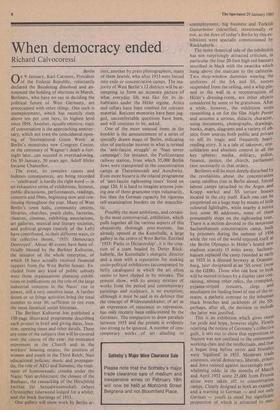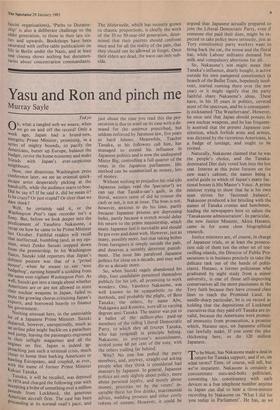When democracy ended
Richard Calvocoressi
Berlin On 9 January, Karl Carstens, President of the Federal Republic, reluctantly declared the Bundestag dissolved and an- nounced the holding of elections in March. Berliners, who have no say in deciding the political future of West Germany, are preoccupied with other things.,One such is unemployment, which has recently risen above .ten per cent here, its highest level since 1958. Another, equally emotive, topic of conversation is the approaching anniver- sary, which not even the coincidental open- ing of 'International Green Week' at Berlin's monstrous new Congress Centre, or the centenary of Wagner's death a fort- night later, can succeed in overshadowing. On 30 January, 50 years ago, Adolf Hitler became Chancellor.
The event, its complex causes and hideous consequences, are being recorded — 'celebrated' is hardly the right word — in an exhaustive series of exhibitions, lectures, public discussions, performances, readings, concerts and films, beginning now and con- tinuing throughout the year. Many of West Berlin's town halls, community centres, libraries, churches, youth clubs, factories, theatres, cinemas, exhibiting associations, art galleries, musical and literary societies, and political groups (mainly of the Left) have contributed, in their different ways, to the collective theme, '1933: Democracy Destroyed'. About 40 events have been of- ficially blessed by the Berliner Kulturrat, the initiator of the whole enterprise, of which 18 have actually received financial support from the West Berlin Senate. Ex- cluded from any kind of public subsidy were those organisations planning exhibi- tions or publications on the role of the large industrial concerns in the Nazis' rise to power, still a very sensitive issue. A further dozen or so fringe activities bring the total number to over 50, sufficient to tire even the most fanatical social historian.
The Berliner Kulturrat has published a 130-page illustrated programme describing each project in brief and giving dates, loca- tion, opening times and other details. These are some of the subjects that will be covered over the course of the year: the resistance movement in the Church and in the workers' housing estates; the position of women and youth in the Third Reich; Nazi educational policies; music and propagan- da; the role of AEG and Siemens; the treat- ment of homosexuals; cinema under the Nazis; Nazi architecture; the closure of the Bauhaus; the ransacking of the Hirschfeld Institut fin- Sexualwissenschaft (where Christopher Isherwood lodged for a while); and the book burnings of 1933.
One gallery will show work by Berlin ar-
tists, another by press photographers, many of them Jewish, who after 1933 were forced into exile or concentration camps. The ma- jority of West Berlin's 12 districts will be at- tempting to form an accurate picture of what everyday life was like for its in- habitants under the Hitler regime. Attics and cellars have been combed for relevant material. Reticent memories have been jog- ged, uncomfortable questions have been, and will continue to be, asked.
One of the more unusual items in the booklet is the announcement of a series of specially drawn maps of Berlin, indicating sites of particular interest in what is termed the 'anti-fascist struggle' or 'Nazi terror campaign': for instance, the Putlitzstrasse railway station, from which 35,000 Berlin Jews were transported to the concentration camps at Theresienstadt and Auschwitz. Even more bizarre is the related programme of 'anti-fascist sightseeing tours' listed on page 120. It is hard to imagine anyone join- ing one of these gruesome trips voluntarily, but then the German capacity for rigorous self-examination borders on the masochis- tic.
Possibly the most ambitious, and certain- ly the most controversial, exhibition, which pulls together all the various aspects of this obsessively thorough post-mortem, has already opened at the Kunsthalle, a large gallery in the centre of West Berlin. Entitled `1933: Paths to Dictatorship', it is the crea- tion of a team headed by Dieter Rtick- haberle, the Kunsthalle's energetic director and a man with a reputation for making socio-political exhibitions (accompanied by hefty catalogues) in which the art often seems to have slipped in by mistake. The present show, with its uneasy mixture of works from the period and contemporary paintings and sculpture, is no exception; although it must be said in its defence that the concept of Widerstandskunst, of art as an expression of resistance to repression, has only recently been rediscovered by the Germans. The temptation to draw parallels between 1933 and the present is evidently too strong to be ignored. A number of con- temporary works of art alluding to unemployment, big business and Turkish Gastarbeiter (identified, intentionally or not, as the Jews of today's Berlin by this ex- hibition) were specially commissioned by R Uckhaberle.
The more theatrical side of the exhibition has not surprisingly attracted criticism, in particular the four 20-foot high red banners inscribed in black with the swastika which hang above the staircase to the cafeteria. Two shop-window dummies wearing the uniforms of the SA and SS, nooses suspended from the ceiling, and a whip pin- ned to the wall in a reconstruction of Hitler's dressing-room, are other objects considered by some to be gratuitous. After a while, however, the exhibition stops resembling a set for the film Night Porter and assumes a serious, didactic character, using documents, photographs, drawings, books, maps, diagrams and a variety of ob- jects from sources both 'public and private to tell its tragic and frequently heart- rending story. It is a tale of takeover, con- solidation and absolute control in all the key spheres: media, military, police, finance, justice, the church, parliament (not necessarily in that order).
Berliners will be most deeply disturbed by the revelations about the concentration camp satellites (ten in Berlin alone), forced labour camps (attached to the Argus and Krupp works) and SS torture houses located in the city itself. Each one can be pinpointed on a huge map by means of little coloured lightbulbs, while nearby a notice lists some 80 addresses, some of them presumably stops on the sightseeing tour. There is a section devoted to the notorious Sachsenhausen concentration camp, built by prisoners during the summer of 1936 while the rest of the world enjoyed itself at the Berlin Olympics in Hitler's brand new stadium scarcely 15 miles away. Sachsen- hausen replaced the camp founded as early as 1933 in a disused brewery at Oranien- burg, later designated at an `SS town' (now in the GDR). Those who can bear to look will be moved to tears by a display case con- taining, among other relics, the crumpled, pyjama-striped trousers, clogs and misshapen tin feeding bowl of one of the in- mates, a pathetic contrast to the inhuman black breeches and jackboots of the SS: perhaps, after all, the decision to include the latter was justified. This is an exhibition which gives cause for pride and hope, however slight. Firmly rejecting the notion of Germany's collective guilt, it sets out to show that opposition to Nazism was not confined to the communist working-class and the intellectuals, and that it began long before terror and brutality were 'legalised' in 1933. Moderate trade unionists, social democrats, liberals, priests and Jews resisted against increasingly over- whelming odds: in the months of March and April 1933 some 25,000 from Prussia alone were taken off to concentration camps. Clearly designed as both an example and a •warning to German — and not only German — youth (a small but significant proportion of which is attracted to fled-
fascist organisations), 'Paths to Dictator- ship' is also a deliberate challenge to the older generation, to those in their late six- ties and upwards. Bookshops have been saturated with coffee-table publications on life in Berlin under the Nazis, and at least one cinema shows nothing but documen- taries about concentration commandants.
The Hitlerwelle, which has recently grown to chaotic proportions, is chiefly the work of the 35-to 50-year-old generation, deter- mined that their parents should confront once and for all the reality of the past, that they should not be allowed to forget. Once their elders are dead, the wave can only sub- side.







































 Previous page
Previous page